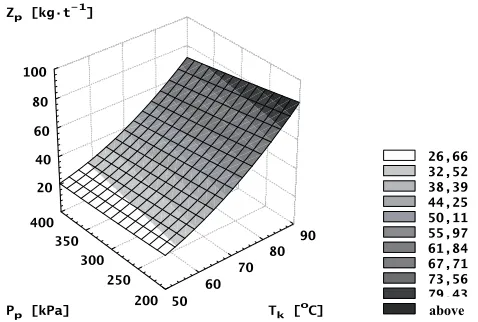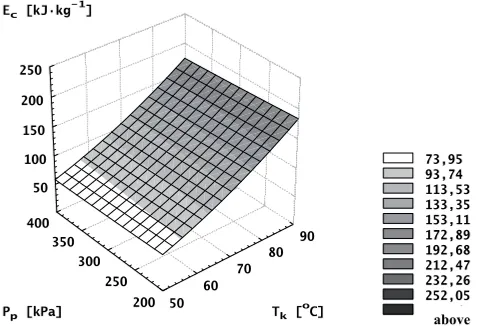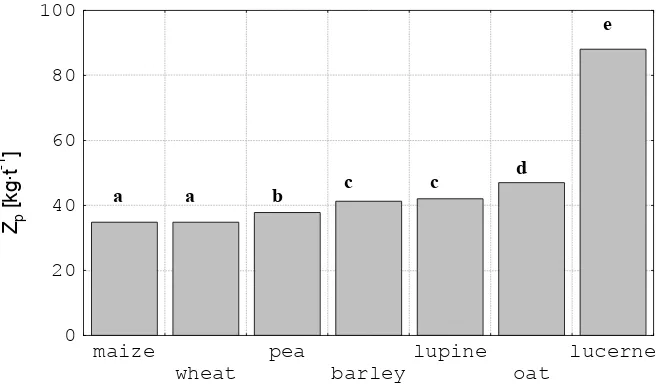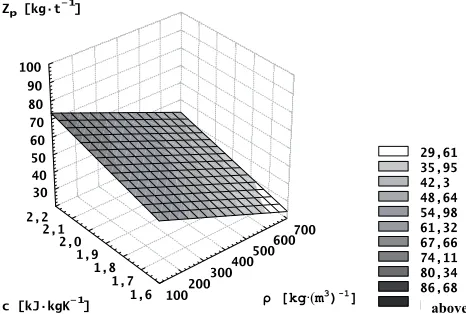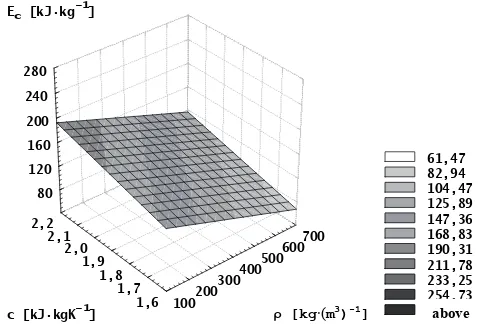STEAM AND HEAT CONSUMPTION DURING CONDITIONING
OF VEGETABLE FEED RAW MATERIALS IN THE PELLETING
PROCESS
Ryszard Kulig
Departament of Machine Operation in Food Industry, Agricultural University in Lublin, Poland
Summary. The paper presents the results of studies on the effects of the parameters of conditioning of selected feed raw materials on the energy consumption of the process. The studies were conducted on a test stand equipped with a microprocessor system measuring steam and heat consumption. The conclusion reached is that the mean values of steam consumption range between 17.03 and 158 kg·t-1, while those of thermal energy consumption – from 41.1 to 516.7 kJ·kg-1. Among the characteristics distinguishing the treated material, speci
fi c heat and bulk density had the most signifi cant impact on heat consumption. The lowest mean demand for thermal energy (91.45 kJ·kg-1) was recorded in maize, while the highest (260.4 kJ·kg-1) – in lucerne.
Key words: pelleting, conditioning, thermal energy, specifi c heat
Nomenclature:
a – thermal expansion coeffi cient, [m2·s-1] c – specifi c heat, [kJ·kgK-1]
E – amount of thermal energy consumed during conditioning, [kJ] Ec – thermal energy consumption, [kJ·kg-1]
ms – weight of ground grain exiting the conditioner, [kg] p – calculated signifi cance level,
Pp – steam pressure, [kPa]
r – Pearson’s correlation coeffi cient R2 – coef
fi cient of determination Tk – conditioning temperature, [oC]
Z – amount of steam consumed during conditioning, [kg] Zp – unit steam consumption, [kg·t-1]
αi – assumed signifi cance level
λ – specifi c heat conductivity, [W·mK-1]
ρn – bulk density, [kg·(m 3)-1]
INTRODUCTION
mate-rial temperature after treatment (usually from 50 to 90oC) as well as to the parameters of process steam [6]. According to Smallman [7], the category of raw materials susceptible to conditioning (i.e. easily absorbing humidity and heat) includes grain as well as high-protein materials with a low fi ber content. Fibrous and oil raw materials are less susceptible to this process.
The intensity of heat and mass exchange during hydrothermal treatment results primarily from the thermo-physical properties of the material, i.e. specifi c heat, specifi c heat conductivity and thermal diffusivity [2]. As reported by Kaleta [3], these properties – with respect to feed raw materials – are the subject of numerous studies and analysis. However, there are no detailed data regarding the effect of the above properties on the parameters of the conditioning process. Literature on the subject focuses mostly on the role of specifi c heat, which is related to the remaining heat values by the following dependence:
n a c
U O
[kJ·kgK-1] (1)
Providing the value of specifi c heat for the most frequently used feed raw materials, Kamiński et al. [4] concluded that this characteristic signifi cantly affects the demand for steam during the pel-leting process. It follows that a mixture of raw materials with higher specifi c heat requires (in order to reach the appropriate temperature for pelleting) a greater addition of water vapor than a mixture of components distinguished by a lower value of this characteristic.
The above fi ndings were partially confi rmed by Vandewalle et al. [8] in studies on condition-ing lucerne meal and ground maize. These authors found that a higher demand for steam is recorded during the treatment of the fi rst raw material (c = 2.3 kJ·kgK-1) compared to the second, which is characterized by a lower specifi c heat value (c = 1.9 kJ·kgK-1).
Determining the thermal energy fl ux supplied with water vapor during conditioning allows to establish the process energy balance as well as unit thermal energy expenditures on the pel-leting technological line. An overview of reference data shows that no comprehensive studies have been carried out so far that would resolve all the issues related to this matter. An aspect that should be pointed out is that the information provided by authors is not in fact confi rmed by experimental results, which is due to the lack of test stands equipped with appropriate measur-ing devices [1]. Therefore, the purpose of this study was to determine steam consumption and thermal energy expenditures during hydro-thermal conditioning of materials of varied physical and chemical properties, at assumed temperature levels acquired as a result of applying steam at various pressure levels.
Despite widespread use of pelleted feeds, so far many process parameters have been de-termined under production conditions in approximation, or certain parameters (such as steam consumption) have been calculated theoretically only. The need to use new, less expensive raw materials, or to prepare new feed recipes, makes it necessary to search for optimal pelleting process parameters. This kind of research may be conducted with the use of the test stand de-signed at the Department of Operation of Food Processing Machinery, University of Agriculture, Lublin [5].
MATERIALS AND METHODS
Table 1. Mean values of specifi c heat (c) of raw materials for the moisture content of 14%
Raw material Barley Maize Wheat Oat Pea Lupine Lucerne
c
[kJ·kgK-1] 1.84 1.92 1.81 1.65 1.78 1.91 2.19
Table 2. Mean bulk density values of raw materials (ρn ) for a moisture content of 14%
Raw material Barley Maize Wheat Oat Pea Lupine Lucerne
ρn
[kg·(m3)-1] 467.2 620.3 592.1 303.2 635.4 591.1 130.34
The hydrothermal conditioning treatment was carried out with the use of a blade conditioner [5], at a rotational speed of the shaft of 300 rev/min with the angle of blades with respect to the shaft axis of 15o. The materials were brought to fi ve temperature levels, i.e. 50, 60, 70, 80 and 90oC. The required temperature following hydrothermal processing was achieved in every instance by water vapor treatment under fi ve pressure levels: 200, 250, 300, 350 and 400 kPa. The level of treatment temperature, depending on the type of material and steam pressure, was determined by controlling the intensity of steam supply to the conditioner.
The tests were conducted on a test stand equipped with a computer system, enabling a detailed analysis of the thermal energy demand within the process. A detailed description of the test stand equipment along with the methodology of determining heat and steam consumption is presented in the work of [5].
Unit demand for steam in the conditioning process was determined by calculating the quotient of the amount of the consumed steam and ground grain mass (generated at identical time intervals) according to the following formula:
U
Zp = s
m Z
·1000 [kg·t-1] (2)
Unit thermal energy expenditures in the conditioning process was calculated from the quotient of the amount of the consumed heat and ground grain mass exiting the conditioner (generated in identical time intervals) according to the following formula:
Ec =
s
m E
[kJ·kg-1] (3)
RESULTS
Fig. 1. presents the results of steam consumption analysis, as dependent upon the conditioning temperature and steam pressure.
Electrical (pressing) energy consumption during pelleting with
steam are shown in Figure 1. Mean values of this parameter varied from
120 to over 200 kJǜ kg -1. The rate of changes in energy consumption was
200 250 300 350 400
Pp [kPa] 200 250 300 350 400
Pp [kPa] 200 250 300 350 400
Pp [kPa] 200 250 300 350 400
Pp [kPa] 200 250 300 350 400
wheat
Electrical (pressing) energy consumption during pelleting with steam are shown in Figure 1. Mean values of this parameter varied from 120 to over 200 kJ· kg -1.
The generated values are within a wide range, from 17.03 to 158.82 kg/t. Changes of similar nature were also recorded for unit thermal energy expenditures (Fig. 3). In this case, the mean values fl uctuated between 41.1 and 516.47 kJ·kg-1.
Fig. 2 and Fig. 3 show that steam and thermal energy consumption per unit increase along with an increase in temperature during hydrothermal treatment, and that in both cases the depend-ence takes the form of a second degree polynomial (Tables 3 and 4). It should be stressed that the low values of regression coeffi cients at variable Tk2 indicate that the effect of temperature on the values of the analyzed parameters within the tested range is close to the linear form.
26,66
It was also observed that an increase in steam pressure results in a decrease in steam con-sumption, upon the same values of conditioning temperature. Due to the fact that steam enthalpy at a pressure of 400 kPa (2738 kJ·kg-1) is only slightly under 2% higher than enthalpy corresponding to 200 kPa (2707 kJ·kg-1), while heat and mass exchange takes place under atmospheric conditions, this is most probably a result of greater heat loss taking place when a lower steam pressure is applied.
73,95 93,74 113,53 133,35 153,11 172,89 192,68 212,47 232,26 252,05 ponad
Tk [oC]
Pp [kPa]
Ec [kJ·kg-1]
50 60
70 80
90
200 250 300 350 400
50 100 150 200 250
above
Fig. 3. Dependence of unit thermal energy expenditures (Ec) on conditioning temperature (Tk) and steam pressure (Pp) (mean values for 7 tested raw materials)
It follows that unit thermal energy expenditures also diminish along with the rise in steam pressure. However, it should be stressed that the rate of these changes is slow, amounting to only a 0.035 unit increase in heat consumption per pressure unit, and is on average 14% lower than the rate of steam consumption increase. The equations describing the effects of conditioning param-eters on the value of unit steam consumption and unit thermal energy expenditures are presented in Tables 3 and 4.
Table 3. Regression equations describing the effect of conditioning temperature (Tk) and steam pressure (Pp) on steam consumption (Zp)
RAW
MATERIAL EQUATION A B C D R2
Wheat Zp = ATk2 – BTk - CPp + D 0,0124 0,7796 0,0245 33,24 0,982
Maize Zp = ATk2 – CPp + D 0,0069 0,0364 10,17 0,972
Barley Zp = ATk2 – BTk - CPp + D 0,0265 2,24 0,0402 80,97 0,987
Oat Zp = ATk2 – CPp + D 0,0081 0,0010 5,70 0,985
Pea Zp = ATk2 – CPp + D 0,0082 0,0395 7,58 0,972
Lupine Zp = ATk2 – BTk - CPp + D 0,0191 1,32 0,0423 49,55 0,982
Table 4. Regression equations describing the effect of conditioning temperature (Tk) and steam pressure (Pp) on unit thermal energy expenditures (Ec)
RAW
MATERIAL EQUATION A C D R2
Wheat Ec = ATk2 – CPp + D 0,0184 0,0359 9,65 0,952
Maize Ec = ATk2 – BTk - CPp + D 0,0373 2,43 0,0375 88,30 0,982
Barley Ec = ATk2 – BTk - CPp + D 0,0725 6,13 0,0407 196,68 0,987
Oat Ec = ATk2 – CPp + D 0,0218 0,0419 12,23 0,991
Pea Ec = ATk2 – BTk - CPp + D 0,0414 2,50 0,0315 77,13 0,992
Lupine Ec = ATk2 – BTk - CPp + D 0,0525 3,57 0,0312 105,45 0,99
Lucerne Ec = ATk2 – BTk - CPp + D 0,2645 27,25 0,011 826,03 0,992
The data presented in Fig. 4 indicate that the lowest demand for steam occurs during the conditioning of ground wheat and maize (no statistically signifi cant differences between the raw materials) and is on average 61% lower than steam consumption recorded for lucerne.
Z
p[
kg
·t
-1
]
0 20 40 60 80 100
maize
wheat
pea
barley
lupine oat
lucerne
a
a
b
c c
d
e
Fig. 4. Dependence of mean steam consumption on the type of raw material (mean values calculated for 5 conditioning temperature levels and 5 steam pressure levels)
Ec
Fig. 5. Dependence of mean unit thermal energy expenditures (Ec) on the type of raw material (mean values calculated for 5 conditioning temperature levels and 5 steam pressure levels)
The statistical analysis based on the obtained results showed that there is a very high positive correlation between steam consumption (r=0.806; p<0.028) as well as heat consumption (r=0.834; p<0.019) and the value of specifi c heat of the tested raw materials (c). However, the predictive value of the obtained regression equations turned out to be insuffi cient since the values of coeffi cients of determination amount to, respectively: R2 = 0.581 for steam consumption and R2 = 0.636 for heat consumption. As a result, taking into account the above fi ndings as well as the fact that in the conditioning process the material is proportioned by volume, another important parameter affecting steam demand and the value of unit thermal energy expenditures is bulk density (Fig. 6 and 7). It is signifi cant due to the fact that the value of this parameter shows considerable variation depending on the type of raw material (Tab. 2).
61,47
Fig. 7. Dependence of unit thermal energy expenditures (Ec) on specifi c heat capacity (c) and bulk density (ρn) (mean values for 7 tested raw materials)
Figures 6 and 7 show that the increase in steam consumption and in unit thermal energy expenditures is directly proportional to the value of specifi c heat capacity of the raw material, and inversely proportional to bulk density. As a result, the dependences may be presented in the form of linear multiple regression models:
Zp = 45.03 c – 0.063 ρu – 8.19; R2 = 0.946 (4)
Ec = 159.31c – 0.187 ρu – 82.03; R2 = 0.964 (5)
CONCLUSIONS
1. Steam consumption in the conditioning process is affected by both temperature of hydro-thermal treatment and steam pressure. An increase in conditioning temperature from 50 to 90 oC results in an average increase in steam and heat consumption by 330%.
2. Along with increasing steam pressure, the effi ciency of heat and mass exchange during conditioning increases and, in consequence, the value of unit thermal energy expenditures decreases insignifi cantly.
3. Among the characteristics distinguishing the treated material, specifi c heat and bulk den-sity have the most signifi cant impact on steam consumption. The obtained dependences take a linear form.
4. The lowest demand for heat is noted during the conditioning of ground wheat and maize (no statistically signifi cant differences between the raw materials) and is on average 63% lower than heat consumption recorded for lucerne.
REFERENCES
Haman J., Szot B., Woźniak W. 1973: Zagadnienia wymiany ciepła i masy w materiałach roślinnych. Problemy Agrofi zyki, WPAN.
Kaleta Agnieszka. Thermal properties of plant materials. Warsaw Agricultural University Press, Warsaw 1999.
Kamiński E., Mulka C., Tylżanowski J. 1975: Ciepło właściwe niektórych surowców paszowych. Biul. Inf. Przem. Pasz., 1-2 : 36-39.
Kulig R., Laskowski J. 2002: Pomiary zużycia pary wodnej w procesie kondycjonowania surowców i mieszanek paszowych. Inżynieria Rolnicza, 4 (24): 134-141.
Laskowski J. 1989: Studia nad procesem granulowania mieszanek paszowych. Seria Wydawnicza – Rozprawy Naukowe, nr 113, Wydawnictwo Akademii Rolniczej w Lublinie.
Smallman C. 1996: Maximising Conditioning Ponential. Feed Milling International, 190 (11): 16-19. Vandewalle P., Melcion J-P., Giboulot B., Le Deschault de Monredon F. 1997: Effect of particle size

